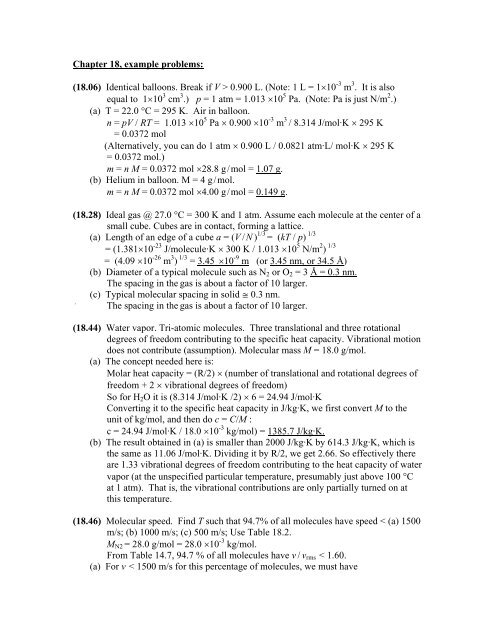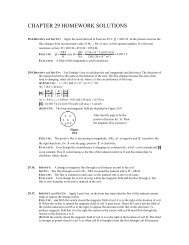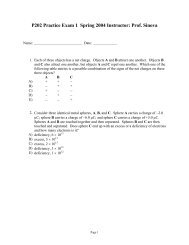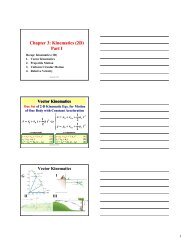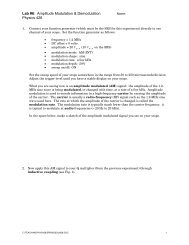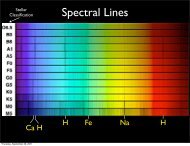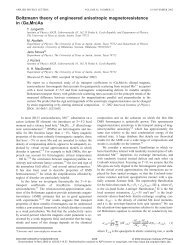Chapter 35, example problems:
Chapter 35, example problems:
Chapter 35, example problems:
You also want an ePaper? Increase the reach of your titles
YUMPU automatically turns print PDFs into web optimized ePapers that Google loves.
<strong>Chapter</strong> 18, <strong>example</strong> <strong>problems</strong>:<br />
(18.06) Identical balloons. Break if V > 0.900 L. (Note: 1 L = 1×10 -3 m 3 . It is also<br />
equal to 1×10 3 cm 3 .) p = 1 atm = 1.013 ×10 5 Pa. (Note: Pa is just N/m 2 .)<br />
(a) T = 22.0 °C = 295 K. Air in balloon.<br />
n = pV / RT = 1.013 ×10 5 Pa × 0.900 ×10 -3 m 3 / 8.314 J/mol·K × 295 K<br />
= 0.0372 mol<br />
(Alternatively, you can do 1 atm × 0.900 L / 0.0821 atm·L/ mol·K × 295 K<br />
= 0.0372 mol.)<br />
m = n M = 0.0372 mol ×28.8 g / mol = 1.07 g.<br />
(b) Helium in balloon. M = 4 g / mol.<br />
m = n M = 0.0372 mol ×4.00 g / mol = 0.149 g.<br />
(18.28) Ideal gas @ 27.0 °C = 300 K and 1 atm. Assume each molecule at the center of a<br />
small cube. Cubes are in contact, forming a lattice.<br />
(a) Length of an edge of a cube a = (V / N ) 1/3 = (kT / p) 1/3<br />
= (1.381×10 -23 J/molecule·K × 300 K / 1.013 ×10 5 N/m 2 ) 1/3<br />
= (4.09 ×10 -26 m 3 ) 1/3 = 3.45 ×10 -9 m (or 3.45 nm, or 34.5 Å)<br />
(b) Diameter of a typical molecule such as N 2 or O 2 = 3 Å = 0.3 nm.<br />
The spacing in the gas is about a factor of 10 larger.<br />
(c) Typical molecular spacing in solid @ 0.3 nm.<br />
.<br />
The spacing in the gas is about a factor of 10 larger.<br />
(18.44) Water vapor. Tri-atomic molecules. Three translational and three rotational<br />
degrees of freedom contributing to the specific heat capacity. Vibrational motion<br />
does not contribute (assumption). Molecular mass M = 18.0 g/mol.<br />
(a) The concept needed here is:<br />
Molar heat capacity = (R/2) × (number of translational and rotational degrees of<br />
freedom + 2 × vibrational degrees of freedom)<br />
So for H 2 O it is (8.314 J/mol·K /2) × 6 = 24.94 J/mol·K<br />
Converting it to the specific heat capacity in J/kg·K, we first convert M to the<br />
unit of kg/mol, and then do c = C/M :<br />
c = 24.94 J/mol·K / 18.0 ×10 -3 kg/mol) = 1385.7 J/kg·K.<br />
(b) The result obtained in (a) is smaller than 2000 J/kg·K by 614.3 J/kg·K, which is<br />
the same as 11.06 J/mol·K. Dividing it by R/2, we get 2.66. So effectively there<br />
are 1.33 vibrational degrees of freedom contributing to the heat capacity of water<br />
vapor (at the unspecified particular temperature, presumably just above 100 °C<br />
at 1 atm). That is, the vibrational contributions are only partially turned on at<br />
this temperature.<br />
(18.46) Molecular speed. Find T such that 94.7% of all molecules have speed < (a) 1500<br />
m/s; (b) 1000 m/s; (c) 500 m/s; Use Table 18.2.<br />
M N2 = 28.0 g/mol = 28.0 ×10 -3 kg/mol.<br />
From Table 14.7, 94.7 % of all molecules have v / v rms < 1.60.<br />
(a) For v < 1500 m/s for this percentage of molecules, we must have
v rms = 1500 m/s / 1.60 = 937.5 m/s. But v rms = (3k B T /m) 1/2 = (3RT /M) 1/2 .<br />
Hence T = M v rms 2 / 3R<br />
= 28.0 ×10 -3 kg/mol × (937.5 m/s) 2 / (3 × 8.314 J/mol·K) = 986.7 K.<br />
(b) For v < 1000 m/s for this percentage of molecules, we must have<br />
v rms = 1000 m/s / 1.60 = 625 m/s. Then<br />
T = 28.0 ×10 -3 kg/mol × (625 m/s) 2 / (3 × 8.314 J/mol·K) = 438.5 K.<br />
(c) For v < 500 m/s for this percentage of molecules, we must have<br />
v rms = 500 m/s / 1.60 = 312.5 m/s. Then<br />
T = 28.0 ×10 -3 kg/mol × (312.5 m/s) 2 / (3 × 8.314 J/mol·K) = 109.6 K.<br />
(18.51) Ice, slowly warmed from very low temperature.<br />
(a) Lowest pressure to observe melting, p 1 = p tp (for H 2 O) = 0.00610 ×10 5 N/ m 2<br />
(= 0.00610 ×10 5 Pa) = 0.00602 atm.<br />
For p < p 1 , only solid to gas phase transition exists.<br />
(b) Maximum pressure p 2 to still be able to observe boiling transition.<br />
p 2 = p critical (for H 2 O) = 221.2 ×10 5 N/ m 2 (= 221.2 ×10 5 Pa) = 218.4 atm.<br />
For p > p 2 , only solid to liquid phase transition exists. Liquid can change to gas<br />
continuously, without showing a phase transition at a particular (pressuredependent)<br />
temperature.<br />
For p 1 < p < p 2 , both solid to liquid and liquid to gas phase transitions exist, in<br />
the sequence: solid → liquid → gas.<br />
(18.60) Flask with a stop cork. V = 1.50 L = 1.50 ×10 -3 m 3 . Filled with C 2 H 6 (ethane gas)<br />
at 300 K and 1 atm = 1.013 ×10 5 N/ m 2 . M ethane = 30.1 g/mol = 3.01 ×10 -2<br />
kg/mol. Warmed to 380 K with stop cork open to atmosphere, then closed<br />
cooled back to 300 K.<br />
(a) According to the ideal gas law, at constant volume and number of moles,<br />
pressure is proportional to absolute temperature. So<br />
Final pressure p final = p initial ×(T final / T initial ) = 1 atm ×(300 K / 380 K)<br />
= 0.789 atm.<br />
(b) How many grams of ethane in the flask<br />
m = nM = (pV / RT) M<br />
= (1.013 ×10 5 N/ m 2 × 1.50 ×10 -3 m 3 / 8.314 J/mol·K × 380 K) × 3.01 ×10 -2 kg/mol<br />
= 0.001448 kg (or 1.448 g).<br />
(18.64) person at rest inhales 0.50 L of air with each breath @ 1 atm and 20.0 °C, containing<br />
21% O 2 .<br />
(a) N (of O 2 ) = (pV / RT) × N A × 21% (of O 2 )<br />
= (1 atm × 0.50 L / 0.0821 atm·L/mol·K × 293 K) × 6.022 ×10 23<br />
molecules/mol × 21% = 2.63 ×10 21 molecules (of O 2 ).<br />
(b) This man is now resting @ 2000 m elevation. T is still 20.0 °C. Oxygen<br />
percentage and volume inhaled the same. Find again N (of O 2 ).<br />
We see that N ∝ p. Pressure is dropped by the factor exp(−mgy / k B T ) =<br />
exp(−Mgy / RT )<br />
= exp (−28.8 ×10 -3 kg/mol × 9.81 m/s 2 ×2000 m / 8.314 J/mol·K × 293 K)
= 0.793<br />
Hence the new number of O 2 molecules is 2.63 ×10 21 molecules × 0.793<br />
= 2.09 ×10 21 molecules<br />
(c) The human body still needs that many O 2 molecules per second at high elevations<br />
as at sea level, so he/she must breath more heavily or more frequently at<br />
high elevations.<br />
(18.68) Insect collisions. Cubic cage 1.25 m on each side Contains 2500 angry bees.<br />
Each flying randomly at 1.10 m/s. We model bees as spheres 1.50 cm in<br />
diameter. On the average,<br />
(a) Mean distance between collisions λ = vt mean = V/4π√2r 2 N<br />
= (1.25 m) 3 / [4π√2 × (0.75×10 -2 m) 2 × 2500] = 0.780 m. (or 78.0 cm.)<br />
(b) t mean = λ / v = 0.780 m / 1.10 m/s = 0.709 s.<br />
(c) Number of collisions per second = 1/ t mean = 1.41 collisions /s.<br />
That this problem is assigned is because insect collisions are similar to molecular<br />
collisions in a gas.<br />
(18.74) Hydrogen gas. Volume V = 5.00 L. Molar mass 2.016 g/mol. Pressure p = 1.01<br />
×10 5 Pa. Temperature T = 300 K.<br />
(a) Total random kinetic energy = N × (3/2) k B T = n × (3/2) RT = (3/2) pV<br />
= (3/2) 1.01×10 5 N/m 2 × 5.00 ×10 -3 m 3 = 757.5 J.<br />
(b) If the tank containing the gas is in a swift jet with velocity 300.0 m/s, by hw<br />
much is the total K.E. increased<br />
The total K.E. is increased by (1/2) m v 2 = (1/2) (2.016 ×10 -3 kg/mol × n) ×<br />
(300.0 m/s) 2 , with n = pV/RT = 1.01×10 5 N/m 2 × 5.00 ×10 -3 m 3 / 8.314 J/mol·K<br />
× 300 K = 0.202 mol. Hence<br />
the increased K.E. = 18.37 J. So the percentage increase in K.E. is 2.42 %.<br />
(c) No. The temperature does not go up, in spite of the fact that the total K.E. has<br />
increased, since the increased K.E. is not associated with random motion.<br />
(18.76) Hydrogen on the sun. Surface temperature T = 5800 K. Consists largely of<br />
hydrogen atoms (not molecules).<br />
(a) v rms = √(3RT/M) = √(3 × 8.314 J/mol·K × 5800 K / 1.008 ×10 -3 kg/mol)<br />
= 11979.8 m/s = 1.198 ×10 4 m/s.<br />
(b) Escape speed = √(2GM/R)<br />
= √(2 × 6.6742 ×10 −11 N·m 2 /kg 2 × 1.99 ×10 30 kg / 6.96 ×10 8 m) = 6.178 ×10 5 m/s<br />
(c) This escape speed is larger than the v rms =1.198 ×10 4 m/s of the hydrogen gas on<br />
the surface of the sun by a factor >50. So very little hydrogen gas can escape the<br />
surface of the sun. Nevertheless, a tiny amount of the hydrogen gas can still<br />
escape the sun because the Maxwell-Boltzmann distribution function says that<br />
there is a tiny fraction of the gas atoms with speed much larger than the rms<br />
speed of the gas atoms. Some of these gas atoms are facing upward, and can<br />
escape the sun’s surface, effectively cooling the sun by a tiny bit. This is called<br />
evaporative cooling, and is used today in some laboratories to cool some trapped<br />
atoms to nano-Kelvin temperatures. (The gas is first cooled to already quite low
temperatures by some other method, and is then cooled further by evaporative<br />
cooling.)


